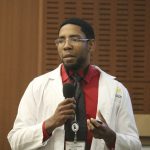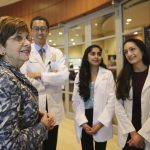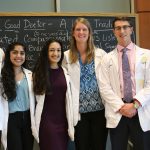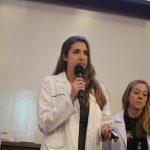 The 26 year-old web developer had a tattoo of the Greek letter, Π on his back which earned him the nickname “Pi” from six medical students who would spend 17 weeks on a mission learning how he died.
The 26 year-old web developer had a tattoo of the Greek letter, Π on his back which earned him the nickname “Pi” from six medical students who would spend 17 weeks on a mission learning how he died.
On February 5, the students made a presentation called “The Life of Pi” that showed they believed their first patient had died of suffocation that left him brain dead. At the conclusion of their report, Team 9 learned they were right. Pi was a competitive swimmer who drowned while practicing breathing exercises.
Autopsy reports are an annual tradition for first-year UCF medical students completing their Anatomy Lab module. Unlike most medical schools, UCF doesn’t tell students their cadaver’s cause of death. Instead students conduct a forensic study of their first patient and use dissection, medical imaging, pathology and research to conclude how and why their patient perished. Students present their autopsy reports to a panel of faculty and only then learn the actual cause of death listed on their patient’s death certificate.
“The very first day I walked in the lab and saw (Pi) I thought I was going to cry,” said Kirsten Hosang, a member of Student Group Nine. “I was really overwhelmed, because I expected to have somebody older, around my grandparents’ age. All of us were around the same age and so we felt very connected to him.”
The cadavers are people who have willed their bodies to science to help train medical students. UCF is one of three locations in Florida where people can make such a donation. This year’s first patients included a 24-year-old with cystic fibrosis who died of respiratory failure, an 81-year-old truck driver who showed signs of asbestos exposure, and a network engineer whose entire stomach was removed during his battle with cancer.
In their presentations, students thanked their patients for their generosity and being “silent teachers” who gave the future doctors lessons in anatomy, disease, dignity and death.
Team 18 had a 67-year-old teacher who was wearing hot pink nail polish when she passed away from lung cancer.
“She was a teacher in life and a teacher in death and we are very grateful to have been her last class of students,” one group member said.
Teams 11 and 17 received awards based on the quality of their presentation and the accuracy of their work. Winning teams will have their names engraved on a plaque in the Anatomy Lab and share a cash prize donated by Dr. Hariharier Subramanian, assistant professor of surgery at the College of Medicine.
Team 11’s patient was an 89-year-old nurse who suffered from Type 1 diabetes. She had developed diabetic ketoacidosis before her death.
“I remember we were all so timid doing the dissections the first couple weeks,” said student Zach Helm. “But the fact that our patient was a nurse, we felt like she really wanted us to learn so much from her and we did.”
In their presentation, Helm and the team told the story of the events leading up to the nurse’s death, beginning with her diagnosis of diabetes at a young age and now the disease gradually affected her body.
“Putting together the story was really a great experience,” Helm said. “We had to connect things in the right way in order for it to make sense; put the puzzle pieces together to find the right answer. And that’s what being a physician is about – asking the right questions and finding the right answers.”
That’s the goal of the Anatomy Lab module, said Dr. Deborah German, vice president for medical affairs and dean of the medical school.
“Anatomy is typically a memory-based course, but ours is a course in curiosity,” she said at the awards ceremony. “This course teaches you to think, learn and discover and this gives you an advantage when you become doctors.”
The following Monday, the students participated in a traditional “Send-Off Ceremony,” in which they paid tribute to their first patients. Some who donate their bodies want them returned to their family for burial. The others are cremated and their ashes scattered in the Gulf of Mexico.
The winning teams are:
Team 11: Elle Crouse, Matthew Moench, David Heaner, Tryphina Mikhail, Zachary Helm, Yasmen Elsawaf
Team 17: Eric Mason, Meena Kanhai, Amanda Cox, Jonathan Keyes, Nicholas Andrews, Ruhi Vasavada





